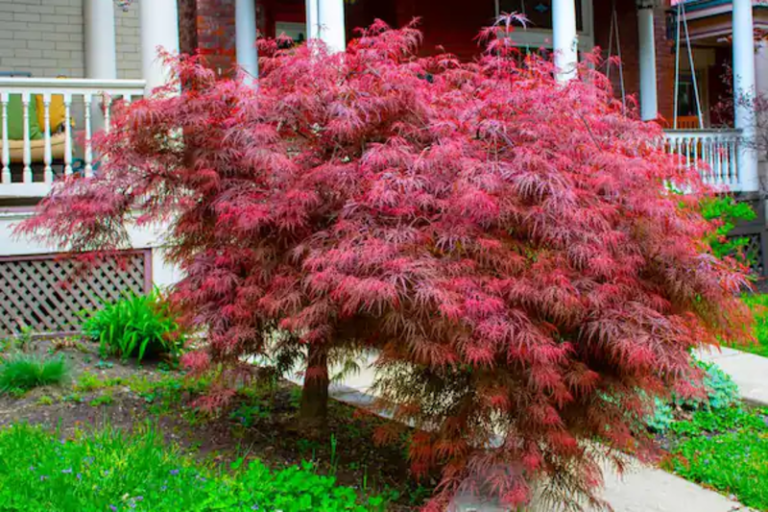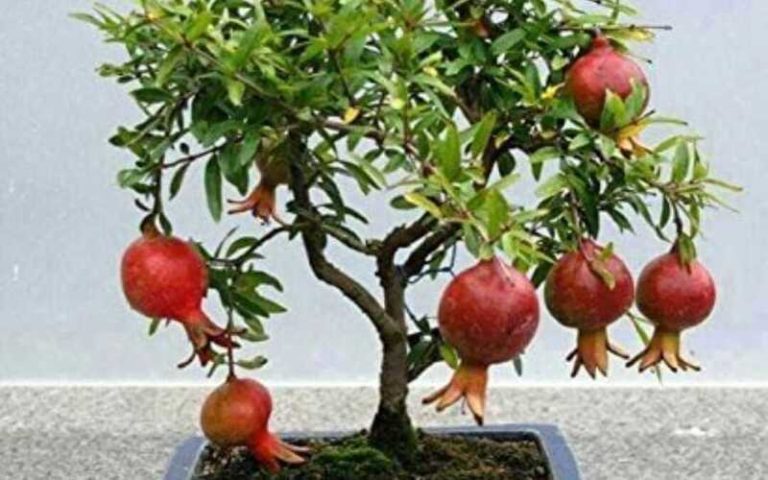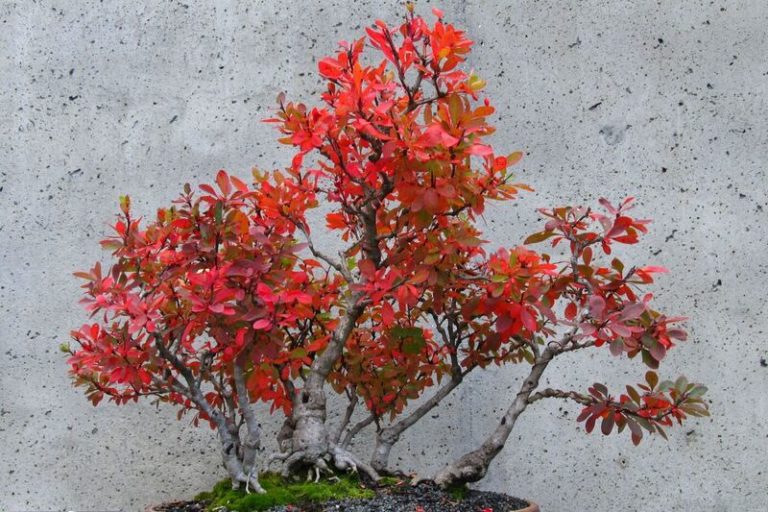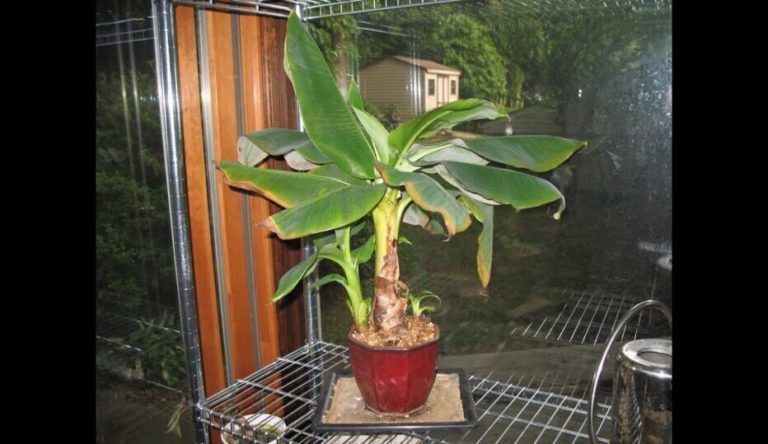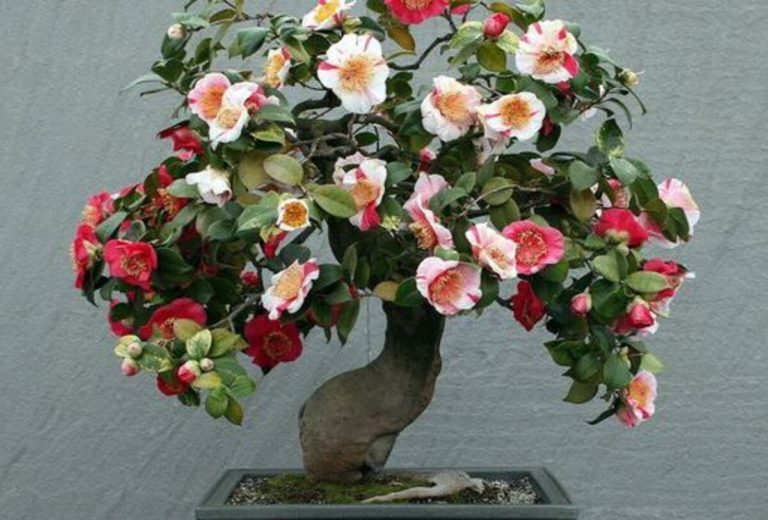Bonsai Papaya Tree : Exploring the Symbolism and Spiritual Significance of Miniature Gardening
Bonsai is the art of growing miniature trees in small pots, and it has been practiced for centuries. One fascinating bonsai variety is the papaya tree. In this article, we will explore the world of bonsai papaya trees, their history, care techniques, styling ideas, and more.
What is a Bonsai Papaya Tree?
A bonsai papaya tree is a small version of the regular papaya tree created through bonsai techniques. It is a miniature tree with scaled-down leaves, a captivating trunk, and sometimes even tiny fruits. Bonsai papaya trees bring the beauty of nature in a compact and artistic form to gardens and bonsai collections.
History and Origins of the Bonsai Papaya Tree
The history and origins of the bonsai papaya tree have a direct connection to bonsai methods and natural papaya tree husbandry.
The art form of bonsai started in ancient China over a thousand years ago. It all started as a method to build little landscapes and show off the beauty of nature in a small place. Bonsai soon made its way to Japan, where it achieved tremendous appeal and refinement.
In contrast, papaya trees have a lengthy history of cultivation in tropical locations. Papaya trees are native to Central America and Mexico and are grown for their wonderful fruits. The cultivation of papaya trees extended throughout time to other regions of the world with suitable conditions.
The idea of combining the art of bonsai with the papaya tree likely emerged as bonsai enthusiasts sought to explore new plant species to transform into miniature versions. Papaya trees, with their tropical appeal and distinctive characteristics, presented an exciting opportunity for bonsai enthusiasts to experiment with.
Today, bonsai enthusiasts all over the world appreciate papaya trees. The art form has evolved to incorporate various techniques specific to growing and maintaining papaya trees as bonsai. These techniques involve careful pruning, shaping, and training to create a bonsai tree that captures the essence of the papaya tree in miniature form.
The bonsai papaya tree is an interesting new addition to the world of bonsai. Its history and roots show how the old art of bonsai and the natural cultivation of papaya trees came together to make it.
Bonsai Papaya Trees and Their Symbolism
The bonsai papaya tree, like other bonsai trees, carries symbolism that reflects the broader concepts and principles associated with bonsai as an art form. Here are some symbolic meanings often associated with bonsai papaya trees:
1.Harmony with Nature: Bonsai, including the bonsai papaya tree, represents a harmonious connection with nature. The careful cultivation and shaping of the tree symbolize our desire to maintain a balance between human intervention and the beauty of the natural world.
2. Patience and Perseverance: Growing a bonsai papaya tree requires patience and perseverance. It takes time and dedication to shape and train the tree into its desired form. The tree serves as a reminder that great things can be achieved through consistent effort and a steadfast approach.
3. Balance and Simplicity: Bonsai papaya trees often embody the principles of balance and simplicity. The careful pruning and shaping of the tree aim to create a harmonious composition that captures the essence of a full-sized papaya tree while maintaining a minimalist aesthetic. It symbolizes the beauty found in simplicity and the importance of balance in life.
4. Longevity and Wisdom: Bonsai plants are known for lasting a long time, and the papaya tree is no different. It shows the passing of time and the gathering of knowledge. As the tree grows and changes, it becomes a sign of patience, strength, and the knowledge gained over time.
5. Tranquility and Serenity: Bonsai papaya trees, like all bonsai trees, evoke a sense of tranquility and serenity. Their small size and carefully crafted appearance create a peaceful ambiance, inviting contemplation and reflection. The tree serves as a reminder to find moments of calmness and serenity amidst the busyness of life.
These symbolic meanings of the bonsai papaya tree help people appreciate and be interested in bonsai as an art form as a whole. Not only does it show the beauty of nature, but it also shows greater philosophical and spiritual ideas that fans and followers can relate to.
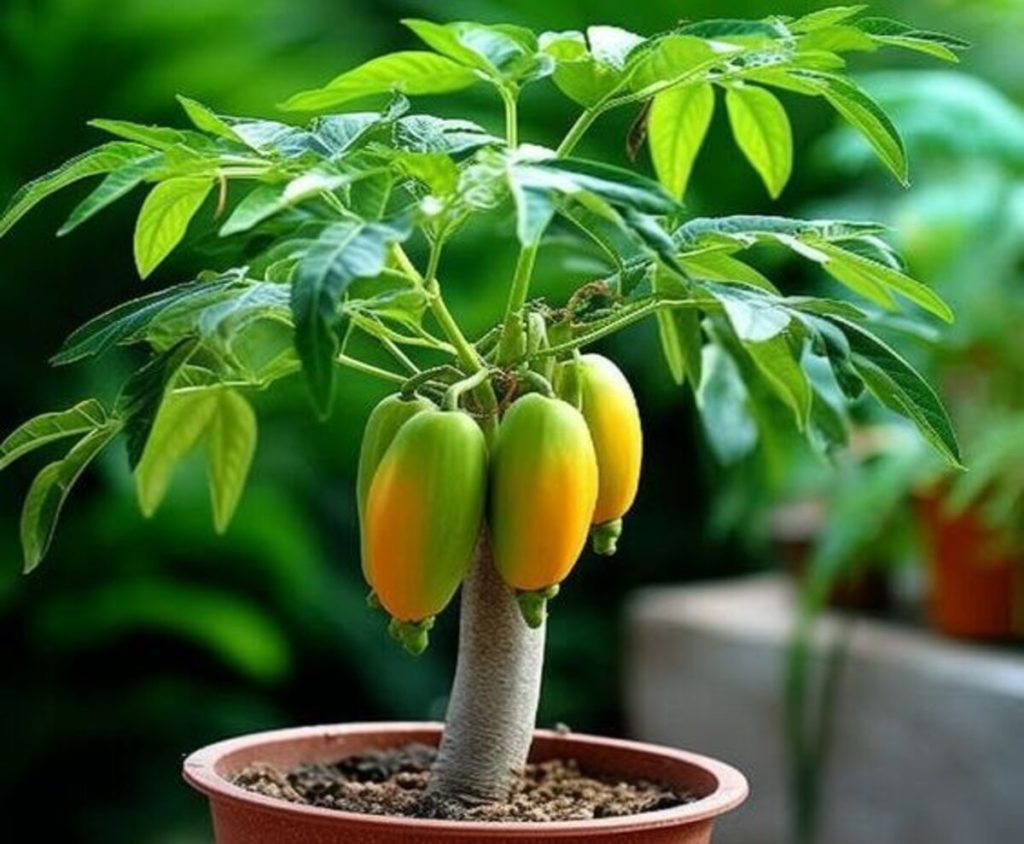
Characteristics of the Bonsai Papaya Tree
The bonsai papaya tree, a tiny counterpart of the ordinary papaya tree, has various distinguishing features that make it distinctive and appealing. The following are some of the important qualities of the bonsai papaya tree:
Miniature Size: The bonsai papaya tree is intentionally cultivated and trained to remain small in size, typically ranging from a few inches to a couple of feet tall. Its compact stature allows it to be displayed and appreciated in small spaces such as tabletops, shelves, or outdoor gardens.
Scaled-Down Leaves: Bonsai papaya trees feature smaller leaves compared to their full-sized counterparts. The leaves are often well-proportioned to the reduced size of the tree, adding to its overall aesthetic appeal.
Attractive Trunk and Bark: The trunk of a bonsai papaya tree is often thick and sturdy, showcasing the papaya tree’s natural growth pattern. The bark may exhibit a textured appearance, enhancing the tree’s visual interest and adding to its character.
Artistic Shape and Form: Through careful pruning, wiring, and training, the bonsai papaya tree can be shaped into various forms and styles, such as the formal upright, informal upright, cascade, or windswept styles. Its artistic form reflects the creativity and vision of the bonsai artist.
Potential for Miniature Fruits: Depending on the size and age of the bonsai papaya tree, it may occasionally produce miniature papaya fruits. While the fruits are smaller in size, they still retain the recognizable papaya shape and may add an additional element of interest to the tree’s overall composition.
Tropical Aesthetics: The bonsai papaya tree retains the tropical aesthetics of the regular papaya tree with its lush, green foliage and exotic appeal. It brings a touch of the tropics to any bonsai collection or garden setting.
Life Span and Growth: Bonsai papaya trees, with proper care, can live for many years, allowing bonsai enthusiasts to enjoy their beauty and the evolving character of the tree over time. They require regular maintenance and occasional repotting to support their growth and health.
The combination of these traits makes the bonsai papaya tree an enticing and unique addition to any bonsai collection. Its small stature, beautiful shape, and tropical allure make it a wonderful and gratifying tree to grow and enjoy.
Types of Bonsai Papaya Tree
While there aren’t as many particular bonsai cultivars for papaya trees as there are for other tree species, selecting suitable papaya variations and cultivating them as bonsai might result in diverse sorts or styles of bonsai papaya trees. Here are a couple such examples:
- Regular Papaya Cultivars: Bonsai papaya trees can be created using regular papaya cultivars commonly grown for their fruits. These cultivars include the Solo, Maradol, Red Lady, and Tainung varieties, among others. By carefully pruning, shaping, and training these cultivars, unique bonsai papaya trees with distinctive characteristics can be created.
- Dwarf Papaya Varieties: Some papaya varieties naturally exhibit dwarf or compact growth habits. These dwarf papaya varieties, such as the Tainung Dwarf or Waimanalo Dwarf, are naturally smaller in size, making them suitable choices for bonsai cultivation. They already possess characteristics that lend themselves well to the bonsai form.
- Seed-Grown Papaya Bonsai: Another approach to creating bonsai papaya trees is to start from seeds. By germinating papaya seeds and carefully nurturing the seedlings, bonsai enthusiasts can train and shape them into bonsai papaya trees. This method allows for more experimentation and customization, as the seed-grown trees can be shaped from an early stage.
- Styling Variations: The style of bonsai papaya trees can vary, resulting in a variety of visual expressions. The formal upright style (with a straight trunk and symmetrical branching), the informal upright style (with a slightly curved or slanted trunk), the cascade style (with a cascading trunk and foliage), the windswept style (with branches shaped by wind effects), and the forest planting style (multiple trees planted together to create a miniature forest) are examples of popular styles.
While these are typical kinds or methods for bonsai papaya trees, the individual cultivar, styling decisions, and techniques used will ultimately establish each bonsai papaya tree’s distinct traits and appearance. Bonsai aficionados can experiment with and explore their own creative ideas in order to produce their own unique styles of bonsai papaya trees.
How to Grow a Bonsai Papaya Tree
Growing a bonsai papaya tree demands special care and attention to detail. Here’s how to cultivate a bonsai papaya tree step by step:
1. Selecting a Papaya Variety: Choose a papaya variety suitable for bonsai cultivation. Regular papaya cultivars or dwarf varieties work well for this purpose.
2. Germination: Begin by growing papaya seeds. Soak the seeds in water for a few hours to soften the outer coating. Plant the seeds in a well-draining seed-starting mix and keep them warm and wet. Provide them with strong, indirect lighting.
3. Seedling Care: Once the seeds germinate and the seedlings emerge, give them plenty of sunshine. Gradually expose them to direct sunshine, but keep them away from extreme heat to avoid burning. For best development, keep the atmosphere warm and humid.
4. Pruning and Shaping: As the seedlings grow, begin pruning to shape the tree. Remove unwanted branches or those that do not contribute to the desired bonsai form. Use sharp bonsai pruning shears to make clean cuts and avoid damaging the tree.
5. Wiring and Training: Use bonsai wiring techniques to guide branches and sculpt the tree’s structure if necessary. Take care not to apply too much pressure, since this might damage the fragile branches. Keep an eye on the wire to make sure it doesn’t cut into the tree as it develops.
6. Repotting: As the bonsai papaya tree matures, it will need to be replanted on a regular basis. Repotting should be done every two to three years, usually in the early spring before the growth season. To maintain an appropriate root system, use a well-draining bonsai soil mix and cut back the roots after repotting.
7. Watering and Fertilizing: Water the bonsai papaya tree thoroughly when the soil becomes slightly dry. Avoid overwatering, as excessive moisture can lead to root rot. Fertilize regularly with a balanced bonsai fertilizer to provide essential nutrients for healthy growth.
8. Sunlight and Temperature: Bonsai papaya trees thrive in warm and sunny conditions. Provide them with at least six hours of direct sunlight each day. Protect them from extreme heat or cold, as papaya trees are sensitive to temperature fluctuations.
9. Pruning Maintenance: Regularly prune and trim the bonsai papaya tree to maintain its shape and size. Remove any dead, diseased, or overgrown branches. This will promote healthy growth and maintain the desired bonsai aesthetic.
10. Pest and Disease Control: Monitor the bonsai papaya tree for pests such as aphids or scale insects. Treat any infestations promptly using organic or appropriate insecticides. Ensure good air circulation and avoid overwatering to prevent fungal diseases.
You may effectively grow and maintain a bonsai papaya tree by following these procedures and giving regular maintenance. To attain the ideal small shape and aesthetic appeal, cultivating a bonsai tree needs time, attention to detail, and regular upkeep.
Benefits of the Bonsai Papaya Tree
The bonsai papaya tree offers several benefits, both aesthetic and practical. Here are some of the advantages of having a bonsai papaya tree:
Miniature Tropical Charm: The bonsai papaya tree brings the beauty and allure of the tropical papaya tree into a compact and manageable form. Its lush green foliage, attractive trunk, and occasionally miniature fruits create a captivating and exotic display.
Space Efficiency: Bonsai papaya trees are small and can be easily accommodated in small spaces such as apartments, balconies, or even indoors. They allow gardening enthusiasts with limited space to enjoy the beauty of a tree without requiring a large garden or outdoor area.
Artistic Expression: Growing and shaping a bonsai papaya tree allows for artistic expression and creativity. The process of training and sculpting the tree enables individuals to create unique and aesthetically pleasing forms, reflecting their personal style and vision.
Stress Relief and Mindfulness: Caring for a bonsai papaya tree can be a therapeutic and mindful activity. Engaging with the tree, pruning, watering, and tending to its needs can help reduce stress, promote relaxation, and enhance mindfulness.
Connection with Nature: Bonsai papaya trees provide a connection with nature, even in urban environments. They bring a touch of the natural world indoors, fostering a sense of tranquility and a reminder of the beauty and wonder of the natural environment.
Educational Value: Growing a bonsai papaya tree offers an opportunity to learn about the life cycle, growth patterns, and care requirements of papaya trees. It provides hands-on experience in horticulture and cultivates a deeper understanding of plant biology and cultivation techniques.
Conversation Starter: Bonsai papaya trees can be a great conversation starter and an interesting addition to social gatherings or garden displays. Their unique appearance and the artistry involved in their creation often pique curiosity and generate discussions about bonsai and horticulture.
Longevity: With proper care, bonsai papaya trees can live for many years, allowing owners to cultivate a long-lasting and evolving relationship with their tree. Witnessing the growth and development of the bonsai tree over time can be a rewarding and fulfilling experience.
Overall, the bonsai papaya tree offers a range of benefits, from providing aesthetic enjoyment and space efficiency to fostering creativity and promoting a connection with nature. It is a unique and rewarding addition to any bonsai collection or garden setting.
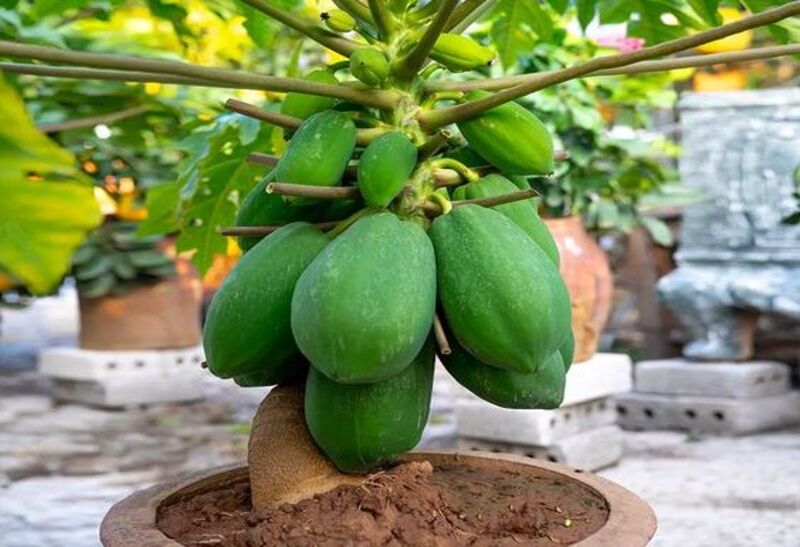
Displaying and Showcasing the Bonsai Papaya Tree
Displaying and showcasing a bonsai papaya tree can enhance its beauty and create a visually striking presentation. Here are some tips for effectively displaying your bonsai papaya tree:
- Choice of Container: Choose a container that matches the design and size of your bonsai papaya tree. Commonly used are traditional ceramic pots or shallow bonsai pots made of clay or porcelain. Choose a container that complements the beauty of the tree and offers a secure base for the tree.
- Stand or Display Table: Consider placing your bonsai papaya tree on a stand or display table to elevate it and create a focal point. Wooden or metal stands can provide an elegant and sturdy platform to showcase the tree’s beauty.
- Positioning: Place your bonsai papaya tree in an area that gets enough light and is easy to see. Make sure there are no other plants or things in the way of it standing out and being the focus of attention. Consider utilizing a rotating stand to exhibit the tree from various perspectives.
- Background and Setting: Consider the background and overall setting when displaying your bonsai papaya tree. A plain backdrop or a neutral-colored wall can enhance the visual impact of the tree. Avoid cluttered or distracting backgrounds that may take away from the tree’s beauty.
- Lighting: To accentuate the features and beauty of your bonsai papaya tree, proper lighting is vital. Place it near a window or in a well-lit location for best results. You may also use artificial illumination, such as adjustable spotlights, to highlight certain elements of the tree if necessary.
- Accent Elements: Enhance the display of your bonsai papaya tree by incorporating accent elements. You can add small figurines, decorative rocks, or a moss cover around the base of the tree to create a natural and harmonious environment.
- Exhibitions and Shows: Participating in bonsai exhibitions and shows provides an opportunity to showcase your bonsai papaya tree to a wider audience. Follow the guidelines and criteria set by the exhibition organizers and ensure your tree is well-maintained and presented professionally.
- Care and Maintenance: Regularly inspect and maintain your bonsai papaya tree to ensure its health and appearance. Prune and shape it as needed, remove any dead or yellowing leaves, and keep the tree free from pests and diseases. A well-maintained tree will make a stronger impression when displayed.
Remember to regularly rotate the position of your bonsai papaya tree to promote even growth and prevent it from leaning towards a single light source. Additionally, seek inspiration from bonsai display books, exhibitions, and the advice of experienced bonsai enthusiasts to further enhance the presentation of your bonsai papaya tree.
Styling and Design of the Bonsai Papaya Tree
Styling and designing a bonsai papaya tree allows for artistic expression and creativity. Here are some common styling options and design ideas for bonsai papaya trees:
Formal Upright Style: The formal upright style showcases a straight, upward-growing trunk with branches gradually tapering in size as they ascend. This style emphasizes a balanced and symmetrical form, reflecting stability and elegance.
Informal Upright Style: The informal upright style, also known as the slanting style, features a slightly curved or slanted trunk. The trunk appears to have been shaped by natural forces, such as wind or gravity, and conveys a sense of dynamic movement and resilience.
Cascade Style: The cascade style mimics the appearance of a tree growing on a cliff or over a precipice. The trunk cascades downward, often below the level of the container, creating a dramatic and flowing silhouette. This style evokes a sense of grace and adventure.
Windswept Style: The windswept look mimics the effect of high winds sculpting the tree over time. The trunk and branches appear to be leaning in one direction, as if subjected to strong winds. In the face of hardship, this design inspires a feeling of tenacity and endurance.
Forest Planting Style: The forest planting style, also known as group planting or yose-ue, involves planting multiple bonsai trees together to create the illusion of a miniature forest. By incorporating several bonsai papaya trees, you can recreate a natural grove-like setting and evoke a sense of serenity and tranquility.
Multiple Trunks: Bonsai papaya trees can be styled with multiple trunks, each showcasing its own unique form and character. The trunks can be intertwined or positioned in a harmonious arrangement, creating a visually dynamic and captivating display.
Driftwood Style: Incorporating natural or artificial driftwood in the design of a bonsai papaya tree can add a sense of age and weathering. The driftwood can be integrated into the composition, enhancing the overall aesthetic and creating an interesting contrast of textures.
Deadwood Techniques: Deadwood techniques involve carving or treating parts of the trunk or branches to simulate aged or weathered wood. These techniques can add character and visual interest to the bonsai papaya tree, making it appear more mature and natural.
When styling a bonsai papaya tree, consider the tree’s natural growth patterns and characteristics. Emphasize its unique features and experiment with different styles and design elements to create a visually captivating and harmonious composition. Remember that styling is a continuous process, and regular maintenance and refinement will be required to achieve the desired aesthetic vision for your bonsai papaya tree.
How to Care for and Maintain a Bonsai Papaya Tree
Caring for and maintaining a bonsai papaya tree requires attention to its specific needs. Here are some essential care tips to keep your bonsai papaya tree healthy and thriving:
- Sunlight and Temperature: Each day, your bonsai papaya tree should receive at least six hours of direct sunlight. Ideal temperatures for papaya trees are between 70 and 85 degrees Fahrenheit (21 and 29 degrees Celsius). Shield the tree from extreme heat and weather.
- Watering: Bonsai papaya trees have moderate water requirements. Water the tree thoroughly when the top inch of soil feels slightly dry. Avoid overwatering, as it can lead to root rot. Ensure proper drainage by using well-draining bonsai soil and a container with drainage holes.
- Humidity: Papaya trees prefer moderate humidity. You may boost the humidity surrounding the tree by placing it on a tray filled with water and rocks. To prevent waterlogging, make sure the bottom of the pot does not come into direct touch with the water.
- Pruning and Shaping: Regular trimming is essential for keeping your bonsai papaya tree in shape and size. Remove any overgrowth, dead or yellowing leaves, and shape the tree as desired. When the tree is dormant or new growth is sprouting, prune it.
- Fertilization: Feed your bonsai papaya tree with a balanced, slow-release bonsai fertilizer during the growing season. Follow the recommended dosage instructions provided by the manufacturer. Reduce or discontinue fertilization during the dormant period.
- Repotting: Repot your bonsai papaya tree every two to three years, ideally in early spring before the growing season begins. Use a well-draining bonsai soil mix and trim back a portion of the roots during repotting to maintain a compact root system.
- Pest and Disease Management: Regularly inspect your bonsai papaya tree for pests such as aphids, mealybugs, or scale insects. Treat any infestations promptly with appropriate organic or chemical insecticides. Avoid overwatering to prevent fungal diseases and provide good air circulation around the tree.
- Seasonal Considerations: During the winter or dormant period, reduce watering frequency and protect the tree from freezing temperatures. If your bonsai papaya tree is kept indoors, ensure it receives adequate light and consider supplementing with artificial lighting during the darker months.
- Observations and Adjustments: Observe your bonsai papaya tree regularly for signs of stress, such as wilting, discoloration, or pests. Make necessary adjustments to its care regimen based on its specific needs and the environment it is kept in.
By providing the proper care and attention, your bonsai papaya tree will flourish and continue to showcase its natural beauty. Regular maintenance, including pruning, fertilizing, and repotting, will help ensure its health and longevity as a cherished bonsai specimen.
Bonsai Papaya Tree Care Sheet
| Aspect | Care Tips |
| Watering | Water thoroughly when the top inch of soil is slightly dry. Avoid overwatering to prevent root rot. |
| Sunlight | Place in a location with at least 6 hours of direct sunlight daily. Protect from extreme heat or cold drafts. |
| Temperature | Maintain temperatures between 70°F to 85°F (21°C to 29°C). Protect from freezing temperatures. |
| Humidity | Increase humidity by placing the tree on a tray with water and pebbles. Avoid waterlogging the pot. |
| Fertilization | Feed with a balanced, slow-release bonsai fertilizer during the growing season. Follow recommended dosage. |
| Pruning and Trimming | Regularly prune to maintain shape and size. Remove excessive growth and dead or yellowing leaves. |
| Wiring and Styling | Use wiring techniques carefully to shape branches. Monitor wiring to avoid damaging the tree. |
| Repotting | Repot every 2-3 years in early spring using well-draining bonsai soil mix. Trim back a portion of the roots. |
| Pest and Disease Control | Regularly inspect for pests. Treat infestations promptly with appropriate insecticides. Provide good air circulation. |
| Winter Care | Reduce watering frequency during winter. Protect from freezing temperatures. Consider supplemental lighting if indoors. |
| Regular Maintenance | Observe for signs of stress and adjust care accordingly. Regularly check soil moisture, prune, and maintain overall health. |
Remember that these are basic principles, and particular care requirements may vary according on the state, habitat, and other characteristics of your bonsai papaya tree. Monitor your tree’s health on a regular basis and make modifications as needed to guarantee its well-being and continuous development.
Conclusion:
Bonsai papaya trees offer a unique and delightful addition to any garden or bonsai collection. With their tropical appeal and miniaturized beauty, they are sure to capture the hearts of bonsai enthusiasts. By following proper care techniques and exploring various styling ideas, you can enjoy the art of growing a miniature papaya tree right in your own home. So why not give it a try and embark on a rewarding journey into the world of bonsai papaya trees?
FAQ:
Q: What is a Bonsai Papaya Tree?
A: A bonsai papaya tree is a miniature version of the regular papaya tree (Carica papaya) that is cultivated and trained using bonsai techniques. It exhibits scaled-down leaves, an attractive trunk, and sometimes miniature fruits, capturing the essence of the papaya tree in a compact form.
Q: Can you bonsai a papaya tree?
A: Yes, it is possible to bonsai a papaya tree. With careful pruning, shaping, and training, a papaya tree can be transformed into a bonsai tree, maintaining its unique characteristics and aesthetics in a smaller size.
Q: Can you dwarf a papaya tree?
A: While papaya trees naturally have a compact size when grown from dwarf varieties, it is not possible to truly dwarf a regular papaya tree. Bonsai techniques can be employed to create the illusion of a small-sized papaya tree, but it will still retain its genetic potential to grow larger if given the opportunity.
Q: How do I keep my papaya tree short?
A: Regular trimming is essential to keep your papaya tree at a manageable size. Reduce top growth to promote branching and a more compact structure. It should be noted that regular trimming may impair the tree’s ability to produce full-sized fruits.
Q: Can papaya be grown in pots?
A: Yes, papaya trees can be grown in pots, including bonsai containers. Dwarf varieties are often preferred for container cultivation as they are more suitable for limited spaces. Ensure the pot has good drainage, use well-draining soil, and provide adequate sunlight and warmth for optimal growth.
Q: Can bonsai papaya trees bear fruit?
A: Yes, bonsai papaya trees can grow fruit, but the size of the fruit will depend on how big the tree is. Bonsai trees that are smaller than their full-sized cousins may have smaller blooms.
Q: How long does it take to develop a bonsai papaya tree?
A: The time it takes to grow a bonsai papaya tree depends on how big the tree was when you started and how mature you want it to be. A well-shaped bonsai can take several years of careful growing and training.
Q: What are common challenges in growing bonsai papaya trees?
A: Common challenges include providing adequate sunlight, maintaining proper watering and drainage, and protecting the tree from pests and diseases. Regular care and attention are essential to ensure the health and vitality of your bonsai papaya tree.
Q: Can papaya trees be grown in pots indoors?
A: While it is possible to grow papaya trees in pots indoors, it can be challenging due to their large size and tropical nature. Dwarf varieties are more suitable for indoor cultivation. Ensure ample sunlight, proper watering, and a warm environment to support their growth.
Also Read:


